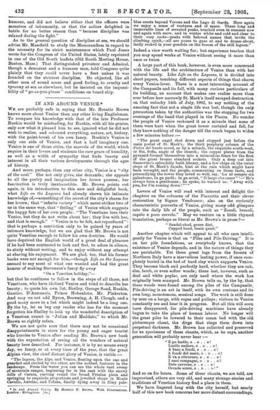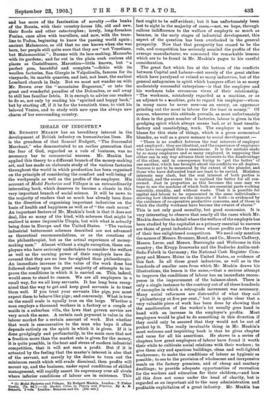To compare his knowledge with , that of the late Professor
Ruskin would be misleading, for Ruskin, with all his genius, only saw what it pleased him to see, ignored what he did not
wish to realise, and coloured everything, nature, art, history, with the paint-brash of his own fancy. Ruskin's Venice is only one side of Venice, and that a half imaginary one. Venice is one of those cities, the marvels of the world, which require in their lovers and students the rare grace of humility, as well as a width of sympathy that finds beauty and interest in all their various developments through the ages
of history.
And more, perhaps, than any other city, Venice is a " city of the soul." She not only gives, she demands ; she appeals to all the poetry and imagination her lovers possess ; her fascination is truly inexhaustible. Mr. Brown points out again, in his introduction to this new and delightful book,
what Life on the Lagoons had already shown his intimate
knowledge of,—something of the secret of the city's charm for her lovers ; that " infinite variety " which never strikes two of us in the same way, that " feeling " of Venice which suggests the happy fate of her own people : " The Venetians love their
Venice, but they do not write about her; they live with her, and that is enough." " Venice is to be felt, not reproduced":
that is perhaps a conviction only to be gained by years of intimate knowledge, but we are glad that Mr. Brown is not quite Venetian enough to follow his own doctrine. He would have deprived the English world of a great deal of pleasure if he had been contented to look and feel, to adore in silence,
to study without writing, and to enjoy without any attempt at sharing his enjoyment. We are glad, too, that his former books were not enough for him,—though Life on. the Lagoons seemed to say most of what one wanted and had the great honour of making Stevenson's fancy fly away "On a Venetian holiday,"— but that he continues to follow in the steps of all those, not Venetians, who have idolised Venice and tried to describe her
beauty ; to quote his own list, Shelley, George Sand, Ruskin,
Gautier, D'Annunzio, Prince Hohenlohe, Mr. Pinkerton. And may we not add Byron, Browning, A. H. Clough, and a good many more to a list which might indeed be a long one.
By the by, let us beg any reader who has for the moment forgotten his Shelley to look up the wonderful description of a Venetian sunset in " Julian and Maddalo," to which Mr. Brown so rightly refers.
We are not quite sure that there may not be occasional disappointments in store for the young and eager tourist
who hurries to Venice after reading Mr. Brown's new book with the expectation of seeing all the wonders of natural beauty here described. For instance, it is by no means every day, we fancy, or at every time of the year, that the great Alpine view, the chief distant glory of Venice, is visible :— "The lagoon, the Alps, and Venice, floating upon the one and guarded and circled by the other, are the noblest features in the pe. From the water you can see the whole vast sweep of mountain ranges, beginning far in the east with the snowy bills of Carnia, curving round the broad Friulan plain and springing to exquisite proportions and jewelled shape in Monte Cavallo, Antelao, and Tofana, finally dying away in filmy pale- • In and. Around Venice. By Horatio F. Brown. With Illustrations. jooadon Itivingtous. [64.] blue crests beyond Verona and the Lago di Garda. Here again we enjoy a sense of vastness and of space. These long and immovable lines of serrated peaks, touched even in summer now and again with snow, and in winter white and cold and clear to their very roots—peaks with beloved names that invite the climbing spirit,—all are yours to gaze at and to dream about, lazily rocked in your gondola on the bosom of the still lagoon."
Indeed a view worth waiting for; but experience teaches that you may spend weeks at Venice without seeing it • more than once or twice.
A large part of this book, however, is even more concerned. with the life and the architecture of Venice than with her natural beauty. Like Life on the Lagoons, it is divided into
short papers, touching different aspects of things that charm every Venice-lover. There is a most interesting account of the Campanile and its fall, with many curious particulars of its building, an account that makes one realise more than ever before how narrowly St. Mark's itself escaped destruction on that unlucky 14th of July, 1902, to say nothing of the amazing fact that not a single life was lost, though the only precaution taken by the authorities was the stopping for two evenings of the band that played in the Piazza. No wonder the people of Venice reckoned it as a miracle that none of them were hurt when the great tower curtsied and fell, for they knew nothing of the danger till the crack began to widen a few minutes before :—
"The great angel shot down and stopped just before the main portal of St. Mark's ; the thick porphyry column of the Pietra del bando saved, as by a miracle, the exquisite south-west, or Sta. Sofia, angle of the church ; the copper plates from the pyramid formed themselves into a miraculous fence for the first of the great bronze standard sockets. Only a deep cut into Sansovino's splendidly built library, and a few chips on the outer steps of St. Mark's facade, hint at the ruin which might have been wrought, and the people, commenting on these facts, and personifying the tower they loved so well, say, ` Lu xe sempre ste galantomo, lu ga parlit ; lu ga avisk " fe largo she casco " '—‘ He's always been a gentleman ; he spoke, he warned us: "Away with you, for I'm coming down ! "' "
Lovers of Venice will read with interest and delight the chapters on the columns of the Piazzetta and their clever restoration by Signor Vendrasco; also on the curiously characteristic proverbs of Venice, giving many odd glimpses into the daily life of the people, such as " Zocoli, brocoli, capelo e poco cervelo." May we venture on a little rhymed translation, perhaps as literal as Mr. Brown's in prose ?-
"Sandal-shod, green diet, Capped head, brain quiet."
Another chapter which will appeal to all who care intelli- gently for Venice is that on "Piles and Pile-Driving." It is on her pile foundations, as everybody knows, that the existence of Venice depends, and in the nature of things they are perishable. Yet these great logs from the forests of Northern Italy have a marvellous lasting power, if once com- pletely buried in the bed of hard clay which supports Venice.
They become black and perfectly hard, whether they are oaks elm, larch, or even softer woods ; these last, however, such as
deal and white poplar, are only used where the work has originally been stamped. Mr. Brown tells us, by the by, that these woods were found among the piles of the Campanile, Pile-driving is an art in itself, with its own customs and its own long, monotonous, musical songs. The work is still done by men on a barge, with ropes and pulleys ; visitors to Venice constantly see and hear it in progress. But all this will soon.
have disappeared, for pile-driving machines have already begun to take the place of human labour. No longer will the great piles be lowered to their ocean bed with the old. picturesque chant, the dirge that rings them down into perpetual darkness. Mr. Brown has collected and preserved for us specimens of these chants, which, as he says, another generation will probably never hear :—
" E po laselo, e . e . . e ! Laselo andare, o . o . . o ! A baso a fondi, e. e . . e! A fondi del mare, o . o . . o ! E va a ritrovare, e. e . . e I suoi compagni, o . o . . o ! Delo cavern, e . e . . e ! Orende scure, o . o . . o ! "
And so on for hours. Some of these chants, we are told, are improvised, others are very old, and many strange stories and traditions of Venetian history find a place in them.
We have lingered long with the city herself, but nearly half of this new book concerns her more distant surroundings, and has more of the fascination of novelty the banks of the Brenta, with their country-house life, old and new, their floods and other catastrophes ; lovely, long-forsaken Fusina, once alive with travellers, and now, with the tram- line to Padua, beginning to know the passing world again ; ancient Malamocco, so old that no one knows when she was born, her people still quite sure that they are "not Venetians, but Malamocchini" ; Burano with its lace-making, Mazzorbo with its gardens ; and far out in the plain such curious old places as Castelfranco, Marostica—little known, but " a perfect gem, beautiful and complete "—Schio with its woollen factories, San Giorgio in Valpolicella, famous for its vineyards, its marble quarries, and last, not least, the earliest Lombard church in Italy. But we must not wander on with Mr. Brown over the " mountains Euganean," or into the great and wonderful paradise of the Dolomites, or sail away to still less familiar Istria. It is enough to advise our readers to do so, not only by reading his " spirited and happy book," but by starting off, if it be for the twentieth time, to visit his beloved Venice, and to study with new eyes the always new charm of her surrounding country.
IDEALS OF INDUSTRY.*











































 Previous page
Previous page